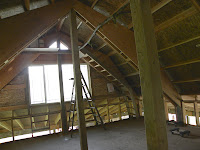Last weekend was the third and final session of the L Program for Learner Judges. At least, the last for us auditors. The candidates will have a D session sometime in the future where they'll have to actually judge classes.
The handout booklet was again excellent. Axel Steiner, a well known judge, was the presenter this time and offered several "Axelisms" as he called them, while explaining the "Collective Marks" that are given at the end of each dressage test after all the movements have been accomplished (or not) and scored. And, like the first two judges, he added little tidbits of "inside" knowledge.
Axelisms: "A counter canter is a true canter going the wrong way." "What you want to see from C of a halt at X is two legs and a smile."
Inside info: A meeting of long-time judges in January discussed the high scores that some dressage horses are now receiving, sometimes for spectacular but not necessarily correct movement. The consensus was that judges need to cool it.
Once again we had lecture and slides and videos in the morning with live horses performing dressage tests in the afternoon. Axel showed a video of some dressage horse prospects in Europe that had been auctioned at one of the premier horse auctions... for many thousands of dollars. He wanted to show us the quality that would earn a 9 or 10 in gaits so we'd know when we looked at the horses in the afternoon how to rate them. As he said, if you give a "nice" horse here a 9, you'd have to give one of those European horses a 15 and the scale only goes to 10.
Axel explained why the collective marks have been changed this year to give much more weight to rider scores (a coefficient of 3 instead of 1): "to address rider issues. Our development of horses has outpaced our development of riders." And to put less emphasis on the gait score because "you can buy gaits". Axel also emphasized that the rider can detract from the horse's gaits and lower its potential score. "When the test goes well, the rider deserves credit. When the test does not go well, the rider must bear the responsibility."
Sunday was the day we evaluated the rider scores for position and seat, effect of the aids, and harmony. I probably learned more from this portion of the L program than any other, at least I hope I learned it. Although I can review the handbook and my voluminous notes, it was really the videos and photos of riders in good and not-so-good positions that helped me understand the importance of "COM over BOS" (Center of Mass over Base of Support). Now if I can only accomplish that when I'm astride.
Unfortunately for my concentration and enjoyment, the 4 a.m. rising on Saturday and lack of regular meals (lunch break and lunch were late and I'd eaten early) started me on the perilous headache/ringing ears Meniere's Syndrome path. The drive home was pretty tough. I had not recovered by 4:30 a.m. Sunday morning and considered staying home. But I really wanted to see the rider position information so took food and ate at the ten a.m. break, again at the 12:30 lunch, and half way through the afternoon. Plus took a nap at the lunch break.
Both Ruth and I left early... she to get to the airport in time for her flight home and me to drive home before I got too dizzy. I cleared my head by stopping at favorite birding spots on the way home and happily found a pair of White-tailed Kites at one and a Bald Eagle at another. I did chores early and slept late on Monday.
But throughout my travails I considered how lucky I am to be able to do all that I do. Walking to the barn in the morning is a privilege, even when it's at 4 a.m.. After the funeral that Johnny and I attended on Friday I know that even breathing is a privilege. The funeral was for a friend my age whose two daughters went to school with our sons. Her husband, another friend of ours, had died years ago of Muscular Dystrophy. He happened to have a rare inheritable type and both their daughters inherited it. These lovely girls, near the age of our two boys, are now both confined to electric wheelchairs and one breathes with the help of a respirator. My little dizzy ear disease pales in comparison. But what love and caring and strength they both exhibited at their last parent's funeral. And Bonnie, the younger one whom I knew the best as a girl, is a self-published author with more books on the way. She can't walk, but she sure can write. Bonnie's tribute to her mother, which her husband read for her at the service, was beautiful.
How incredibly fortunate are the riders and candidates and auditors at Devonwood to be able to follow our dreams, ride our horses, and muck out our barns with limbs that move where we ask them to. I swore after Friday's funeral that I would never complain again about my aches and ailments.
Of course, that didn't last. But maybe I'll at least complain less.








 March also saw a full moon at perigee, the closest the moon comes to earth in its elliptical orbit. So-called a "Super Moon", it just looked like a full moon to me, remarkable only for the fact that the March clouds cleared enough for us to see it.
March also saw a full moon at perigee, the closest the moon comes to earth in its elliptical orbit. So-called a "Super Moon", it just looked like a full moon to me, remarkable only for the fact that the March clouds cleared enough for us to see it.










































